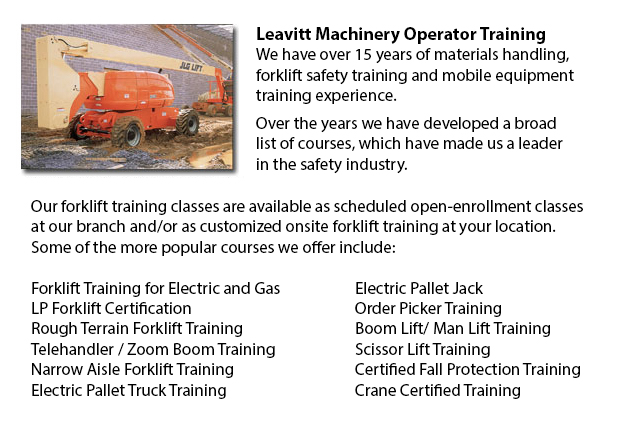
Oshawa Boom Lift Certification - Making use of elevated work platforms allow for maintenance operations and work to be performed at elevated work heights that were otherwise not reachable. Boom Lift Certification Training educates workers regarding the safe operation of scissor lifts and boom lifts.
Despite the range in lift style, applications and site conditions, all lifts have the potential for death or serious injury when not safely operated. Falls, electrocution, tip-overs and crushed body parts could be the terrible result of wrong operating procedures.
In order to avoid aerial lift incidents, boom lift operators have to be trained by qualified workers in the safe operation of the particular type of aerial lift they will be making use of. Aerial lifts should never be modified without the express permission of the manufacturer or other recognized entity. If you are renting a lift, ensure that it is properly maintained. Before using, safety devices and controls should be checked to ensure they are properly working.
It is essential to follow safe operating procedures to be able to avoid workplace accidents. Driving an aerial lift while the lift is extended must not be done, nevertheless, some models are designed to be driven when the lift is extended. Always set brakes. Set outriggers, if available. Avoid slopes, but when needed make use of wheel chocks on slopes which do not exceed the manufacturer's slope limitations. Adhere to load and weight restrictions of the manufacturer. When standing on the platform of boom lifts, utilize full-body harnesses or a safety belt with a two-foot lanyard tied to the boom or basket. Fall protection is not needed for scissor lifts that have guardrails. Never sit or climb on guardrails.
The boom lift certification course provides instruction in the following fields: safety guidelines in order to prevent a tip-over; training and certification; inspecting the work area and travel path; surface conditions and slopes; stability factors; other guidelines for maintaining stability; weight capacity; leverage; pre-operational check; testing control functions; safe operating practices; mounting a vehicle; safe driving procedures; overhead obstacles and power lines; PPE and fall protection; use of harnesses and lanyards; and prevent falling from platforms.
When successful, the trained worker will know the following: pre-operational check procedures; authorization and training procedures; how to avoid tip-overs; factors affecting the stability of scissor and boom lifts; how to utilize the testing control functions; how to utilize PPE and strategies to be able to avoid falls.
-
Oshawa Scissor Lift Operator Certification
Oshawa Scissor Lift Operator Certification - North American regulators recommend that worksites need operators of scissor lifts, booms or aerial work platforms to obtain certification training. Scissor lift operator certification is not mandatory, bu... More -
Narrow Aisle Forklift / Order Picker Training / Electric Pallet Jack / Electric Pallet Truck Training in Oshawa
A pallet lift is a model of equipment dedicated in the moving of pallets of many dimensions and weights. They might be utilized as an appendage for platform lifts, cranes and other types of heavy machinery or be applied on their own. Pallet hoists ar... More -
Oshawa Crane Operator Certification
Oshawa Crane Operator Certification - The process to permit people to be able to operate certain kinds of cranes is to take crane operator certification training to get certification. The certification process incorporates classroom learning, hands-o... More -
Oshawa Aerial Platform Training
Oshawa Aerial Platform Training - Aerial platform lifts might be utilized to accomplish a lot of unique tasks executed in hard to reach aerial places. A few of the odd jobs associated with this style of lift include performing routine repair on build... More -
Oshawa Forklift Certification Schools
Oshawa Forklift Certification Schools - Forklift Certification is mandatory within North America. Hence, forklift training programs are important both for companies and for people seeking jobs in industries as forklift operators. Forklift training fo... More -
Oshawa Heavy Equipment Ticket
Oshawa Heavy Equipment Ticket - Depending on the nature of the job at hand, the type of construction equipment that a heavy equipment operator makes use of varies. Each and every type of machine is built to perform specific jobs in the most effective... More -
Oshawa Heavy Equipment Certification
Oshawa Heavy Equipment Certification - Large pieces of machines and heavy-duty vehicles are usually known as heavy equipment. This broad term includes utility vehicles from forestry and agricultural implements to civil engineering vehicles, construct... More -
Oshawa Overhead Crane Safety Training
Oshawa Overhead Crane Safety Training - The overhead crane safety training program is meant to equip the operators with the right skills and knowledge in the areas of: crane safety precautions, accident avoidance, materials handling, and equipment an... More

Forklift Certification Oshawa
TOLL FREE: 1-888-254-6157
Oshawa, Ontario
forkliftcertificationoshawa.com
Email Us
About Us


